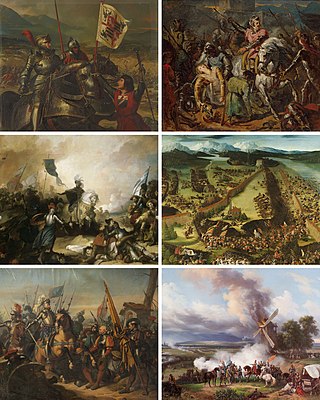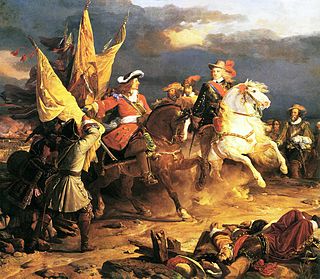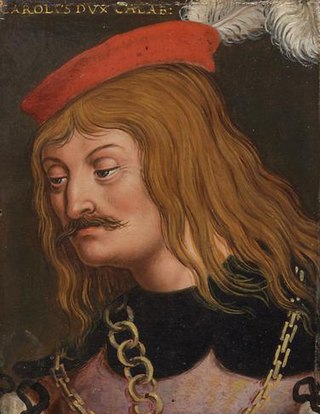
Year 1315 (MCCCXV) was a common year starting on Wednesday of the Julian calendar.

Year 1319 (MCCCXIX) was a common year starting on Monday of the Julian calendar.

The Italian Wars were a series of conflicts fought between 1494 and 1559, mostly in the Italian Peninsula, but later expanding into Flanders, the Rhineland and Mediterranean Sea. The primary belligerents were the Valois kings of France, and their Habsburg opponents in the Holy Roman Empire and Spain. At different points, various Italian states participated in the war, some on both sides, with limited involvement from England and the Ottoman Empire.

Philip I of Taranto, of the Angevin house, was titular Latin Emperor of Constantinople by right of his wife Catherine of Valois–Courtenay, Despot of Romania, King of Albania, Prince of Achaea and Taranto.

The Battle of Campaldino was fought between the Guelphs and Ghibellines on 11 June 1289. Mixed bands of pro-papal Guelf forces of Florence and allies, Pistoia, Lucca, Siena, and Prato, all loosely commanded by the paid condottiero Amerigo di Narbona with his own professional following, met a Ghibelline force from Arezzo including the perhaps reluctant bishop, Guglielmino degli Ubertini, in the plain of Campaldino, which leads from Pratovecchio to Poppi, part of the Tuscan countryside along the upper Arno called the Casentino. One of the combatants on the Guelph side was Dante Alighieri, twenty-four years old at the time.
Uguccione della Faggiuola was an Italian condottiero, and Ghibelline magistrate of Pisa, Lucca and Forlì.

Castruccio Castracani degli Antelminelli was an Italian condottiero and duke of Lucca.

The Battle of Montaperti was fought on 4 September 1260 between Florence and Siena in Tuscany as part of the conflict between the Guelphs and Ghibellines. The Florentines were routed. It was the bloodiest battle fought in Medieval Italy, with more than 10,000 fatalities. An act of treachery during the battle is recorded by Dante Alighieri in the Inferno section of the Divine Comedy.

The Italian Wars of 1499–1504 are divided into two connected, but distinct phases: the Second Italian War (1499–1501), sometimes known as Louis XII's Italian War, and the Third Italian War (1502–1504) or War over Naples. The first phase was fought for control of the Duchy of Milan by an alliance of Louis XII of France and the Republic of Venice against Ludovico Sforza, the second between Louis and Ferdinand II of Aragon for possession of the Kingdom of Naples.

The Battle of Bitonto was a Spanish victory over Austrian forces near Bitonto in the Kingdom of Naples in the War of Polish Succession. The battle ended organized Austrian resistance outside a small number of fortresses in the kingdom.

The Battle of Villaviciosa was a battle between a Franco-Spanish army led by Louis Joseph, Duke of Vendôme and Philip V of Spain and a Habsburg-allied army commanded by Austrian Guido Starhemberg. The battle took place during the War of the Spanish Succession, one day after a Franco-Spanish victory at Brihuega against a British army under James Stanhope, 1st Earl Stanhope. Both Philip V of Spain and the Archduke Charles of Austria claimed victory, but the number of dead and wounded, the number of artillery and other weapons abandoned by the Allied army and the battle's strategic consequences for the war confirmed victory for Philip.

Charles, Duke of Calabria, was the Duke of Calabria from 1309 until his death. Upon his father's elevation as King of Naples, he was made vicar-general of Naples and duke of Calabria He was elected as signore by the city of Florence in 1326. Charles died on 9 November 1328 in Naples.
The Battle of Falconaria was fought in the latter days of the War of the Sicilian Vespers. Fought on 1 December 1299 between the forces of Frederick II of Sicily and Philip I of Taranto of the Kingdom of Naples, it was a momentous victory for Frederick and a disaster for Philip, who was captured.

The siege of Florence took place from 24 October 1529 to 10 August 1530, at the end of the War of the League of Cognac. At the Congress of Bologna, the Medici Pope Clement VII and Emperor Charles V agreed to restore the Medici family in Florence. A large Imperial and Spanish army under Philibert of Châlon, Prince of Orange and Pier Maria III de' Rossi surrounded the city and after a siege of nearly ten months, captured it. They overthrew the Republic of Florence and installed Alessandro de' Medici as the ruler of the city.

The Battle of Marciano occurred in the countryside of Marciano della Chiana, near Arezzo, Tuscany, on August 2, 1554, during the Italian War of 1551. The battle marked the defeat of the Republic of Siena in its war against the Duchy of Florence, and resulted in Siena losing its independence and being absorbed into the Duchy of Florence.
Peter, called Tempesta, was the Count of Eboli from 1306. He was the eighth son of Charles II of Naples and Maria of Hungary. His sobriquet came from his stormy temperament.
Charles of Taranto was the eldest son of Philip I, Prince of Taranto and titular Latin Emperor of Constantinople, and his wife, Thamar Angelina Komnene, daughter of the Despot of Epirus, Nikephoros I Komnenos Doukas.
The following is an overview of the armies of First Crusade, including the armies of the European noblemen of the "Princes' Crusade", the Byzantine army, a number of Independent crusaders as well as the People's Crusade and the subsequent Crusade of 1101 and other European campaigns prior to the Second Crusade beginning in 1147.
Simone della Tosa was an Italian statesman and historian. He is noted for writing chronicles of his native Florence, for the period from 1115 to 1379, annotated and published by Domenico Maria Manni in 1733.













